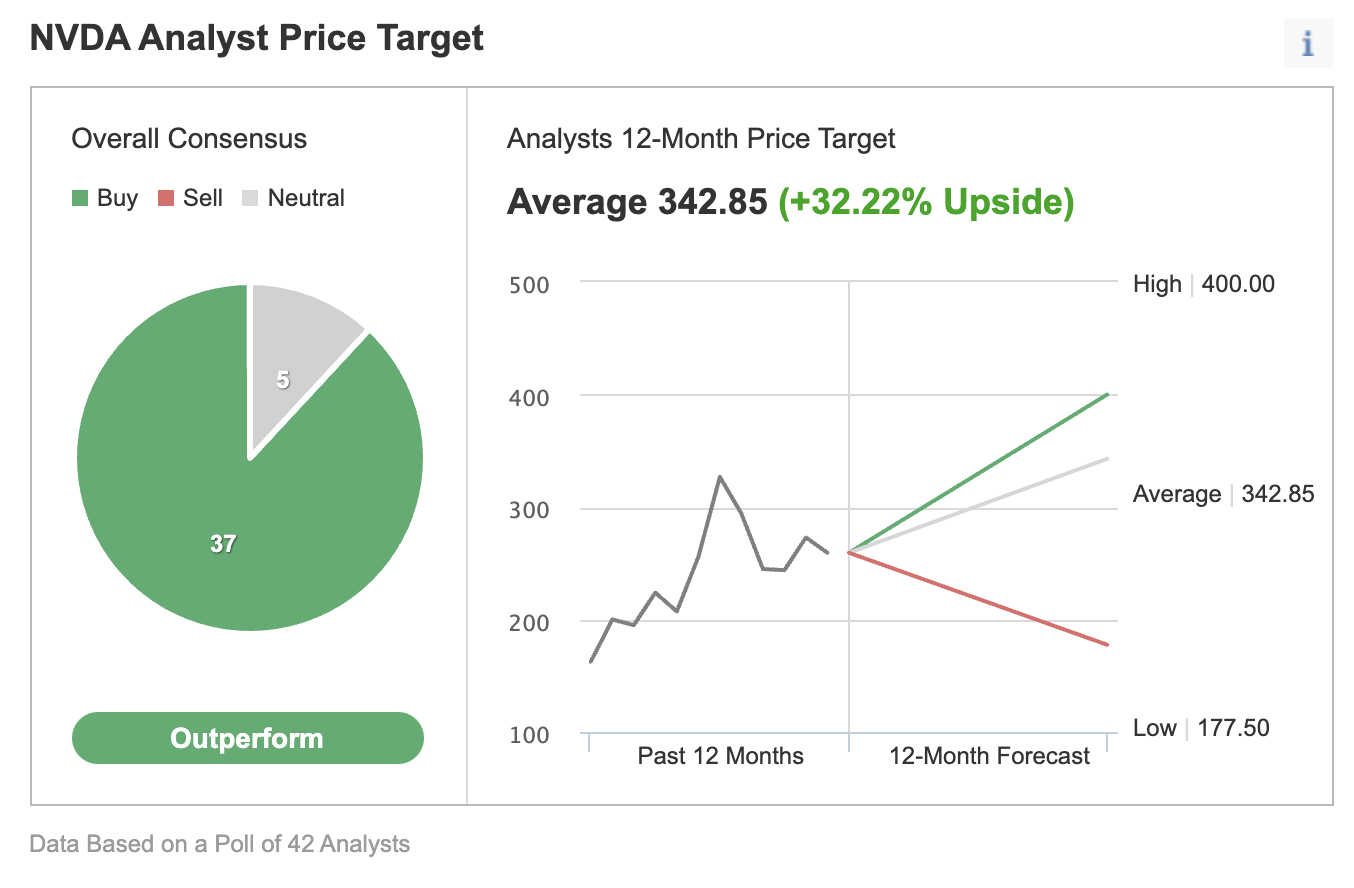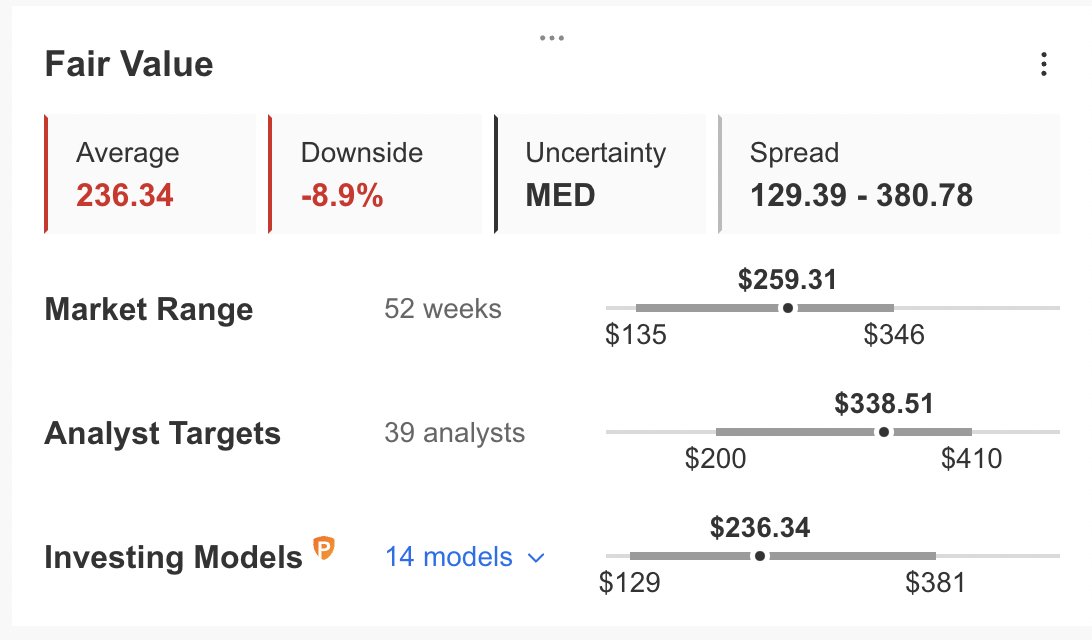- Semiconductor giant NVIDIA has lost over 10% since January
- Supply chain constraints likely to persist, creating headwinds
- Long-term investors could consider buying the dip, especially if shares decline toward $250
So far in 2022, investors in the semiconductor behemoth NVIDIA (NASDAQ:NVDA) have not had much to celebrate. The stock has lost close to 10.3% since the start of the year and it has declined about 24.5% since it hit a record high of $346.47 in November 2021.

By comparison, the Philadelphia Semiconductor Index is down 17.1% year-to-date and competitors, Intel (NASDAQ:INTC) and Advanced Micro Devices (NASDAQ:AMD) are down 6.2% and 24.9% respectively, YTD.
Recent Metrics
Deloitte highlights that the global semiconductor chip industry should “grow 10% in 2022 to over $600 billion.” With a market capitalization of $659.5 billion, NVIDIA is the most valuable semiconductor company.
Management released robust Q4 financials and FY 2022 metrics on Feb. 16. Results were better than consensus estimates.
Revenue was $7.6 billion, up from $5 billion a year ago. The Santa Clara, California-based semiconductor supplier generated $3.42 billion revenue from gaming, up 37% year-over-year. Data center top line was $3.26 billion, up 71%.
Meanwhile, the two other segments, i.e., professional visualization and automotive and robotics, generated revenues of $643 million and $125 million, respectively. It reported diluted EPS of $1.32 in the fourth quarter versus 78 cents per share a year ago.
Management currently expects to achieve revenue of $8.1 billion (plus or minus 2%) in Q1 FY23.
On the results, CFO Colette Kress commented:
“We had an excellent quarter with revenue up 53% year-on-year to $7.6 billion. We set records for total revenue as well as for gaming, data center and professional visualization. Full-year revenue was a record $26.9 billion, up 61%, compounding the prior year's growth of 53%.”
Prior to the release of Q4 results, NVDA stock was changing hands at around $263. As we write, shares are at $262.60.
What To Expect From NVIDIA Stock
Among 42 analysts polled via Investing.com, NVDA stock has an "outperform" rating. Wall Street also has a 12-month median price target of $342.85 for the stock, implying an increase of more than 30% from current levels. The 12-month price range currently stands between $177.50 and $400.

Source: Investing.com
However, according to a number of valuation models, including P/E, P/S or terminal values, the average fair value at InvestingPro stands at $236.34.

Source: InvestingPro
In other words, fundamental valuation suggests shares should roughly decline by 10%.
At present, NVDA’s P/E, P/B, and P/S ratios are 68.5x, 25.1x, and 24.8x. Comparable metrics for peers in the information technology sector stand at 25.6x, 8.7x, and 7.6x.
Our expectation is for the shares to trade in a wide range, between $230 and $270, to build a base in the coming weeks, and then they could potentially start a new leg up.
Adding NVDA Stock To Portfolios
NVIDIA bulls, who believe the decline in the stock is likely to come to an end, could consider investing now. Their target price would be $342.85 or analysts’ forecast.
Although investors might want to buy NVDA stock for their long-term portfolios, they could also be nervous about further volatility in the coming weeks. Therefore, some might prefer to put together a "poor man’s covered call" on the stock instead.
So, today, we introduce a diagonal debit spread on NVIDIA by using LEAPS options, where both the profit potential and the risk are limited.
Most option strategies are not suitable for all retail investors. Therefore, the following discussion on NVDA stock is offered for educational purposes and not as an actual strategy to be followed by the average retail investor.
Diagonal Debit Spread On NVDA Stock
Price at time of writing: $262.60
A trader first buys a longer term call with a lower strike price. At the same time, the trader sells a shorter term call with a higher strike price, creating a long diagonal spread.
Thus, the call options for the underlying stock have different strikes and different expiration dates. The trader goes long one option and shorts the other to make a diagonal spread.
Most traders entering such a strategy would be mildly bullish on the underlying security. Instead of buying 100 shares of NVDA, the trader would purchase a deep in the money LEAPS call option, where that LEAPS call acts as a “surrogate” for owning the stock.
For the first leg of this strategy, the trader might buy a deep in the money (ITM) LEAPS call, like the NVDA Jan. 19, 2024, 210-strike call option. This option is currently offered at $94.25. It would cost the trader $9,425 to own this call option, which expires in less than two years, instead of $26,260 to buy the 100 shares outright.
The delta of this option is close to 80. Delta shows the amount an option’s price is expected to move based on a $1 change in the underlying security.
If NVDA stock goes up $1 to $263.60, the current option price of $94.25 would be expected to increase by approximately 80 cents, based on a delta of 80. However, the actual change might be slightly more or less depending on several other factors that are beyond the scope of this article.
For the second leg of this strategy, the trader sells a slightly out of the money (OTM) short-term call, like the NVDA May 20 270-strike call option. This option’s current premium is $14.05. The option seller would receive $1,405, excluding trading commissions.
There are two expiration dates in the strategy, making it quite difficult to give an exact formula for a break-even point. Different brokers might offer “profit-and-loss calculators” for such a trade setup.
Maximum Profit Potential
The maximum potential is realized if the stock price is equal to the strike price of the short call on its expiration date. So, the trader wants the NVDA stock price to remain as close to the strike price of the short option (i.e., $270) as possible at expiration (on May 20), without going above it.
Here, the maximum return, in theory, would be about $1,859 at a price of $270 at expiry, excluding trading commissions and costs. We arrived at this value using an options profit-and-loss calculator. Without the use of such a calculator, we could also arrive at an approximate dollar value. Let’s take a look:
The option seller (i.e., the trader) received $1,405 for the sold option. Meanwhile, the underlying NVIDIA stock increased from $262.60 to $270, a difference of $7.40 per share, or $740 for 100 shares.
Because the delta of the long LEAPS option is taken as 80, the value of the long option will, in theory, increase by $740 X 0.8 = $592.
However, in practice, it might be more or less than this value. There is, for example, the element of time decay that would decrease the price of the long option. Meanwhile, changes in volatility could increase or decrease the option price as well.
The total of $1,405 and $592 comes to $1,997. Although it is not the same as $1,859, we can regard it as an acceptable approximate value.
Understandably, if the strike price of our long option had been different (i.e., not $210), its delta would have been different, too. Then, we would need to use that delta value to arrive at the approximate final profit or loss value.
Here, by not investing $26,260 initially in 100 shares of NVIDIA, the trader’s potential return is leveraged.
Ideally, the trader hopes the short NVDA call will expire out of the money, or worthless. Then, the trader can sell one call after the other, until the long NVIDIA LEAPS call expires in over a year and half.
